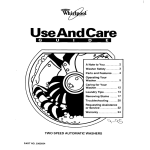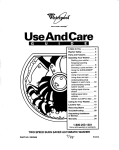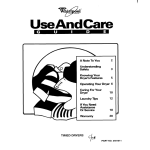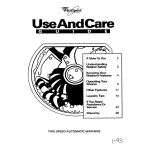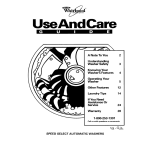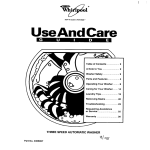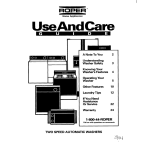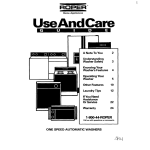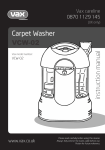Download Whirlpool 3360464 Washer User Manual
Transcript
HOW TO MAKE A HOME Rfl:’ UseAndCare \ /A A Note to You ......................... 2 Washer Safety ........................ 3 Parts and Features.. Operating ............... 4 Your Washer ......... 5 Caring for Your Washer ....... 12 Laundry Removing Tips.. ....................... 13 Stains . . .. . .. .. . .. .. .. .. 17 Troubleshooting . . .. . ... . .. .. . .. .. . 20 Requesting Assistance or Service . .. . .. .. .. .. . .. . .. .. .. . .. .. .. . 22 Warranty TWO SPEED AUTOMATIC PART NO. 3360464 Rev. A . .. .. .. . ... . .. . .. .. . .. .. .. .. . .. 24 WASHERS A Note to You Because your life is getting busier and more complicated, Whirlpool* washers are easy to use, save time, and help you manage your home better. To ensure that you enjoy years of trouble-free operation, we developed this Use and Care Guide. It contains valuable information about how to operate and maintain your washer properly and safely. Please read it carefully. Please record your model’s information. Whenever you call to request service on your appliance, you need to know your complete model number and serial number. You-can find this information on the model and serial number plate (see diagram on page 4 for location of plate). Please also record the purchase date of your appliance and your dealer’s name, address, and telephone number. Keep this book and the sales slip together Model Number Serial Number Purchase Date Dealer Name Dealer Address Dealer Phone in a safe place for future reference. Washer Safety Your safety is important to us. This guide contains safety statements under warning symbols. Please pay special attention to these symbols and follow any instructions given. Here is a brief explanation of the symbol. IMPORTANT SAFETY Read all instructions before using your washer. l Do not machine wash or machine dry items cleaned, washed, soaked in, or spotted with wax, paint, gasoline, oil, or other flammable fluids. The fumes can create a fire hazard or explosion. Always hand wash and line dry items containing these materials. l Flammable fluids (dry-cleaning solvents, kerosene, gasoline, etc.) should not be used or stored in or near your washer. Do not add flammable fluids to your wash water. These substances give off vapors that can create a fire hazard or explosion. l Do not allow children to operate, play with, or crawl on or inside your washer. Supervise children closely when your washer is used near them. l Before your washer is removed from service or discarded, remove the lid to prevent accidental entrapment. *After starting a cycle, do not reach into the basket unless the Cycle Control Knob is pushed in and all motion stoos. l Do not tamper with the controls. l This symbol alerts you to such dangers as personal injury burns fire and 1 electrical shock. ’ ’ ’ INSTRUCTIONS If your hot water has not been used recently (usually 2 weeks or longer), hydrogen gases may build up in your water heater and your hot water pipes. HYDROGEN GAS IS EXPLOSIVE. To prevent injury or damage, before using your washer, turn on all hot water faucets and allow water to run for several minutes. This will allow gases to escape. Do not smoke or use any open flame near your faucet while it is open. Please . .. l Have only a qualified person install, repair, or replace parts on washer. l Maintain washer properly. l Protect washer from the weather and keep it where the temperature will not fall below freezing. l Install and level washer on a floor that can support the weight.+ l Connect washer to the correct 3-prong outlet, electrical supply, water supply, and drain.+ l Ground washer properly.’ See the Installation Instructions. l - SAVE THESE INSTRUCTIONS Understanding l l l your - responsibilities Store laundry aids and other materials in a cool, dry place where children cannot reach them (in a locked cabinet if possible). Read and follow instructions on packages of detergent and laundry aids, especially warnings and precautions. Do not wash or dry items that are soiled with vegetable or cooking oil. These items may contain some oil after laundering. Due to the remaining oil, the fabric may smoke or catch fire by itself. l l l Do not use chlorine bleach and ammonia or acids (such as vinegar or rust remover) in the same wash. Hazardous fumes can form. Unplug power supply cord before attempting to service your washer. Do not machine wash fiberglass materials. Small particles can stick to fabrics washed in following loads and cause skin irritation. 3 Parts and Features The parts and features of your washer are illustrated on this page. Become familiar with all parts and features before using your washer. NOTES: l l The drawings in this book may vary from your washer model. They are designed to show the different features of all models covered by this book. Your model may not include all features. Page references are included next to some features. Refer to those pages for more information about the features. Load size selector \ (p. 5) Temperature Extra Rinse option+ (P. 6) Cycle control knob (P. 5) Fabric softener dispense (P. 11) Agitator (under lid) Basket Tub (P. 10) +Available on some models On your Control Panel 0 means OFF. 4 Operating Your Washer To obtain the best washing results, you must operate your washer properly. This section gives you this important information, Page references are included for more information. Starting Your Washer 1. Add measured detergent to the washer. Then place a sorted load of clothes in the washer. l Sort and load clothes as described on page 13. l If desired, you may also add color-safe all-fabric bleach. 2. (OPTIONAL STEP) If desired, add measured fabric softener to the fabric softener dispenser as described on page 11. 3. Close the washer lid. 4. Select a Load Size. Turn the Load Size Selector to the setting that corresponds with the size of the wash load and the type of fabric being washed.. l To change the load size setting after the washer has started to fill, move the Selector to the desired new setting. NOTE: If your washer has RESET on the Load Size Selector, change the load size selection by first moving the Selector to RESET, then to the new load size. l See pages 13 and 14 for loading tips. 5. Select a wash-rinse temperature with the Water Temperature Selector. Match the water temperature with the type of fabric and soils being washed. See page 15 for water temperature guidelines. l Your washer has one of the Water Temperature Selectors shown: rotary knob or push button. Fabric softener dispenser Knob Selector Knob Selector Knob Selector “Reset” with 6. (OPTIONAL STEP) If your washer has an Extra Rinse Selector, you can set it to On to add an additional rinse to the end of the wash cycle. l Use the extra rinse option when using extra detergent for the Super Wash cycle or any of the following cycles: Regular, Permanent Press, Knits Gentle, or Woollens. l Before a cycle starts, select Extra Rinse On. The washer automatically adds an extra rinse and spin to the cycle. l If you do not want an extra rinse and spin, select Extra Rinse Off. 7. Push in and turn the Cycle Control Knob clockwise. Stop when the indicator on the outer ring points to the number in the wash cycle you want. l The numbers are minutes of wash time. . The cycles are described on pages 7-9. 8. Pull out Cycle Control Knob to start washer. 9. (OPTIONAL STEP) If desired, add measured liquid chlorine bleach after the washer starts agitating. See page 11. Stopping/restarting washer l l your To stop the washer at any time, push in the Cycle Control Knob. To restart the washer, close the lid (if necessary) and pull out the Cycle Control Knob. Selecting a cycle and time Use the information in this section to help you make the best cycle selections for your wash loads. Each cycle is designed for different types of fabrics and soil levels. l The washer pauses briefly throughout each cycle. These pauses are normal for washer operation. l Refer to page 10 to help you understand what happens during a wash cycle. Cycles may vary with model 6 Regular cycle The Regular cycle features the Gentle Wash system and high spin speeds to shorten drying time. l Use NORMAL, 10 to 14 minutes of wash time, to clean cotton and linen fabrics that are moderately to heavily soiled. l Use LIGHT, 6 minutes of wash time, to clean cotton and linen fabrics that are lightly soiled. Permanent Press Regular cycle cycle The Permanent Press cycle features the Gentle Wash system, a cool-down rinse, and low spin speeds to reduce wrinkling. l Use 12 minutes of wash time to clean permanent press and some synthetic fabrics that are moderately soiled. NOTE: The washer pauses briefly during the wash cycle. This is normal for washer operation. Knits Gentle Permanent Press cycle cycle The Knits Gentle cycle features a reduced agitation speed for gentle soil removal. Low spin speeds reduce wrinkling. l Use 6 minutes of wash time to clean delicate items and washable knits that are lightly soiled. Woollens (on some cycle Knits Gentle cycle models) The Woollens cycle features a reduced agitation speed for gentle soil removal. Select warm wash and warm rinse water when usi’ng this cycle. l Use this 4 minute cycle for washable woollens and lightly soiled knits. Woollens cycle 7 Soak cycle (on some models) The Soak cycle features brief periods of agitation and soak time to help remove heavy soils and stains that need pretreatment. l Use warm water when soaking laundry. (Hot water can set stains.) See pages 17-l 9 for stain removal information. l Use the amount of detergent or presoak additive recommended by the manufacturer. l After the Soak cycle ends, add detergent and set a new wash cycle. Pre-Wash (on some cycle models) The Pre-Wash cycle features a brief period of high speed agitation to help remove heavy soils and stains that need pretreatment. l Use warm water for prewashing stained laundry (Hot water can set stains). See pages 17-l 9 for stain removal information. NOTE: After the Pre-Wash cycle ends, add detergent and set a new wash cycle. Super (on some Wash cycle models) Super Wash automatically prewashes the laundry and advances into the Regular wash cycle. (The washer does not need to be reset after the Super Wash cycle). Use this cycle when washing heavily soiled loads that need maximum soil removal. l For proper cleaning, use double the amount of detergent recommended for a regular wash cycle. NOTE: The machine pauses during Super Wash. This is normal for washer operation. 8 Pre-Wash cycle Using Rinse and Spin NOTE: If your washer has the Extra Rinse option, see page 6. When using extra detergent for heavilysoiled clothes, or washing special-care items, you may want an extra rinse and spir 1. 1. Push in the Cycle Control Knob and turn clockwise to RINSE, as illustrated. 2. Pull out the Cycle Control Knob. The washer fills to the selected load size, agitates, drains, and spins. Using Drain and Spin A drain and spin may help shorten drying times for some heavy fabrics or special-care items by removing excess water. 1. Push in the Cycle Control Knob and turn clockwise to SPIN, as illustrated. 2. Pull out the Cycle Control Knob. The washer drains, then spins. 9 What happens in each cycle When the Cycle Control Knob is set to a number and pulled out, the washer fills (to the selected load size) before agitation and timing start. The washer begins agitating immediately after filling; agitation can occur with the washer lid up or down. After agitation starts, the Cycle Control Knob turns clockwise until it points to an OFF area and the cycle ends. The washer pauses briefly throughout each cycle. These pauses are normal for washer operation. WASH Fill 4 I?3 c II w Wash selected time -et4 Drain (or partial drain+) No agitation +The Permanent Press cycle partially drains, fills, agitates briefly, and drains. Spin MAGIC RINSE w Fill 4 Rinse Drain-No agitation w Spin-Spray l&J Spin CLEAN* lint filter The lint filter at the bottom of the washer basket cleans itself. During agitation, wash and rinse water passes over the filter, separating the lint from the water. The lint is then spun away from the filter and out of the system during the spin part of the cycle. If your washer drains into a tub, remove any lint collected in the tub or strainer. MAGIC CLEAN lint filter 10 Basket interior rinse Using the fabric softener dispenser 1. Add detergent and load clothes into the basket. 2. Pour liquid fabric softener into the dispenser using the amount recommended on the package. Avoid dripping or spilling any fabric softener on the load. 3. Dilute fabric softener with warm water. Fill dispenser with warm water until liquid reaches the opening. 4. Start the washer. Diluted fabric softener will be added to the load during the final rinse. NOTE: Do not stop the washer before the rinse part of the cycle begins. Staining can occur. 5. Flush dispenser periodically with warm water. NOTE: Do not wash dispenser removed. bleach to dispenser. liquid fabric softener Adding clothes with this Do not add detergent or The dispenser is for use only. liquid chlorine bleach Always measure liquid chlorine bleach. Do not guess. Never use more than 250 mL (1 cup) for a full load. Use less with lower water level settings. Follow manufacturer’s directions for safe use. Use a cup with a pouring spout to avoid spilling. 1. Let the washer fill and begin agitating the load. 2. Add bleach to wash cycle so it can be removed in the rinse cycle. Pour bleach around agitator, not directly on load. 9 Follow directions on care labels. Do not use chlorine bleach on wool, silk, spandex, acetates, or some flameretardant fabrics. l When soaking with chlorine bleach, add detergent to soak water. NOTE: Undiluted bleach will damage any fabric it touches. The damage appears as rips, holes, tears, or color loss and may not show up until several washings later. 11 Caring for Your Washer Proper care of your washer can extend its life. This section explains how to care for your washer properly and safely. Cleaning your washer Interior Exterior q I Wipe up detergent, bleach, and other spills with a soft, damp cloth or sponge as they occur. Occasionally wipe the outside of the washer to keep it looking like new. Do not put sharp or metal objects in your washer. They can damage the finish. Check all pockets for pins, clips, money, bolts, nuts, etc. Do not lay these objects on your washer after emptying pockets. Winter storage Clean interior with 250 mL (1 cup) of chlorine bleach mixed with 500 mL (2 cups) of detergent. Run washer through a complete cycle using hot water. Repeat process if necessary. NOTE: Remove hard water deposits using cleaners labeled as washer safe only. or moving care Install and store your washer where it will not freeze. Because some water may stay in the hoses, freezing can damage your washer. If storing or moving your washer during freezing weather, winterize it. To winterize washer: To use washer again: 1. Shut off both water faucets. 1. Flush water pipes and hoses. 2. Reconnect water inlet hoses. 2. Disconnect and drain water inlet hoses. 3. Put 1L (1 quart) of R.V.-type antifreeze in 3. Turn on both water faucets. the basket. 4. Reconnect power supply cord. 4. Run washer on a drain and spin setting 5. Run the washer through a complete cycle (see page 9) for about 30 seconds to mix with 250 mL (1 cup) of detergent to clean the antifreeze and water. out antifreeze. 5. Unplug the power supply cord. Non-use or vacation You should operate your washer only when you are at home. If you will be on vacation or not using your washer for an extended period of time, you should: l Unplug the power supply cord or turn off electrical power to the washer. 12 care l Turn off the water supply to the washer. This helps avoid accidental flooding (due to a water pressure surge) while you are away. Laundry Tips This section reviews proper laundering techniques information. Preparing l l l clothes and gives you additional washing for washing Close zippers, snaps, and hooks to avoid snagging other items. Remove pins, buckles, and other hard objects to avoid scratching the washer interior. Remove nonwashable trim and ornaments. Empty pockets and turn them inside out. Turn down cuffs, brush away lint and dirt. . Turn synthetic knits inside out to avoid pilling. l Tie strings and sashes so they will not tangle. l Mend tears, loose hems, and seams. l Treat spots and stains. (See “Removing Stains” on pages 17-I 9.) l Stained or wet garments should be washed promptly for best results. Sorting l Separate heavily soiled items from lightly soiled ones, even if they would normally be washed together. Separate lint givers (towels, chenille) from lint takers (corduroy, synthetics, permanent press). When possible, turn lint givers inside out. l l Separate dark colors from light colors, colorfast items from noncolorfast items. Sort by fabric and construction (sturdy cottons, knits, delicate items). Loading Drop items into washer loosely. Fill to the top of the basket, but do not wrap items around the agitator. Items should move easily through wash water for IELI best cleaning and wrinkle-free results. Items should sink and reappear later. l Load washer properly and select correct load size setting. Overloading or packing the machine, and selecting a setting too small for the wash load can: - cause poor cleaning. - increase wrinkling. - create excessive lint. -wear out items faster (because of pilling). l l l l l Load by the amount of space items take up, not by their weight. Mix large and small items in each load. Load evenly to maintain washer balance. An off) balance load can make the \ --’ -washer vibrate during spin. H Use a large load size setting to reduce wrinkling with permanent press clothes and some synthetic knits. These items should have more room to move in the water than heavy items (towels, jeans). Reduce wash time when using a small load size setting. Loads with only a few small items need less wash time. Loading suggestions For these suggested full-sized loads, set the Load Size Selector to the highest load size setting. ’ LARGE CAPACITY Heavy Work Clothes 2 pair pants 3 shirts 3 pair jeans 1 coverall Permanent Press 1 double sheet 1 tablecloth 1 dress 1 blouse Mixed Load 2 double or 1 king size sheet 4 pillowcases 6 T-shirts 62 pair shorts Knits 2 slacks 2 blouses 4 shirts 4 tops 2 dresses 32 slacks shirts 2 pillowcases 2 shirts blouses 6 handkerchiefs SUPER CAPACITY l l l Permanent Press 2 double or 1 king size sheet 1 tablecloth 1 dress 1 blouse 2 slacks Mixed Load 3 double sheets 4 pillowcases 8 T-shirts 6 pair shorts 2 shirts 2 blouses Knits 3 slacks 3 blouses 6 shirts 4 tops 4 dresses 3 shirts 2 pillowcases 8 handkerchiefs Delicates 2 camisoles 4 slips 4 panties 2 bras 2 nighties Towels 10 bath towels 10 hand towels 14 wash cloths 1 bathmat Delicates 3 camisoles 1 quilted robe 4 slips 4 panties 2 bras 2 nighties 1 baby’s dress energy Use warm or cold wash water for most loads. Use hot water only when washing heavy, greasy soils or whites. Use cold rinses. Wash full loads. Use lower water levels when washing small loads. 14 Towels 8 bath towels 8 hand towels 10 wash cloths 1 bathmat WASHERS Heavy Work Clothes 3 pair pants 3 shirts 4 pair jeans 1 coverall 1 overall Saving l WASHERS l l Avoid rewashing. Use enough detergent and pretreat stains or heavy soils. Use the cycles and wash times recommended for the fabric and soil. Use your washer during off-peak hours usually early morning and late evening. (Ask your power company.) Water Selecting Guidelines water WASH WATER TEMPERATURE+ HOT 54°C (130°F) or above temperatures SUGGESTED l l l WARM 32”-44°C (90”-110°F) l l l l COLD 21”-32°C (70”-90°F) l l l COMMENTS FABRICS Work clothes Sturdy whites/colorfast pastels Diapers l l l Dark/noncolotfast colors Permanent press items Nylon, polyester, acrylics, silks, woollens Knits/delicate fabrics Extra-sensitive colors Noncolorfast items Hand washables l l l l l l l Best cleaning for heavily soiled items Removes oils, perspiration, greasy soils, and stains Prevents graying or yellowing Best for lightly soiled to moderately soiled items Safe for most fabric finishes Less fading and dye bleeding Reduces wrinkling Best for very lightly soiled items Saves hot water Best rinse water temperature The washer features cold rinses for all wash temperatures. In addition, on some models, warm rinses are available with hot washes. Warm rinse water provides better water extraction than cold rinse water, but may increase wrinkling when line drying. In cold climates, warm rinse water also provides a more comfortable temperature for handling the wash load. Checking hot water temperature Your hot water should be 54°C (130°F) or above. If you do not know your hot water temperature, you can check it easily. You may need to raise the temperature of your water heater. To check your hot water: 1. Fill a pan with the hottest water available from the faucet that fills your washer. NOTE: If you do not have a faucet at your washer site, collect the water from the faucet closest to your washer. 2. Place a candy thermometer or cooking thermometer in the water to check the temperature. Water hardness Many poor washing results can be traced to the hardness of the wash water. To check your water hardness: l City water - ask the city water company. l Well water - ask the local water authority. Ask for the mineral content in grains/gallon or parts/million. If your water is more than 8 grains/gallon or more than 153 parts/ million, you should consider: l Installing a water softener. l Using more detergent. l Using a packaged water conditioner. l Not using soap. NOTE: In wash water temperatures colder than 21 “C (7O”F), detergents do not dissolve well. Also, soils may be difficult to remove, and some fabrics may retain wear wrinkles and may have increased pilling. 15 Washing special-care items Most garments and household textiles have care labels with laundering instructions. Always follow care label directions when they are available. Below are general washing instructions for some special washables. ITEM CARE INSTRUCTIONS Blankets (electric or woollen) Pretreat spots and stains. Select water temperature, cycle, and time according to the type of blanket being washed. Use of the Extra Rinse feature may be necessary. Check care label to see if manufacturer recommends machine washing. Curtains, drapes, slipcovers Wash small loads. Crowding may cause wrinkling. Replace slipcovers while still slightly damp. They will dry to fit tightly. NOTE: Sun-damaged curtains and draperies will tear whether hand or machine washed. Diapers Elastic, When using chlorine bleach for soaking, add extra detergent to the load. Avoid overuse of fabric softeners - absorbency will be reduced. spandex Elastic picks up oil from the body. Oil can damage elastic. Wash often to reduce the damage. Use warm water and sufficient detergent to remove oils. Do not use chlorine bleach. Flame-retardant clothing Items will be clearly labeled as flame-retardant. Follow manufacturer’s instructions to retain flame-retardant qualities. Knits Knits are comfortable to wear because they stretch. However, this means that knits are more likely to be stretched and damaged when washed (especially bulky knits). Knits made of synthetic fabrics such as polyester, nylon, and acrylic tend to keep their original shape more than a knit made of cotton or ramie. Pillows, toys stuffed Washing feather pillows is not recommended dried in a dryer. Plastic, items rubber Treat as delicate items. Wash in warm water. Wash small items in a mesh bag. Quilts, bedspreads Scatter rugs Snowsuits, 16 unless they will be Do not wash cotton-filled comforters unless they are quilted or stitched. Tucked cotton batting tends to slip and become lumpy. Use of the Extra Rinse feature may be necessary. Shake or vacuum rugs to remove loose dirt. Wash more than one rug at a time. If washing only one rug, add bath towels to balance the load. jackets Wash only one or two items at a time. You may need to stop the washer occasionally to press air from the items being washed. Use of the Extra Rinse feature may be necessary. Removing Stains Stained, heavily soiled, or greasy items may need to be prewashed or soaked for best results. Soaking helps remove protein-type stains like blood, milk, or grass. Prewashing loosen soil before washing. Stain l l l l l rules Use warm water for soaking or prewashing stained laundry. Hot water can set stains. Most stains are easier to remove when they are fresh. Old or set stains may not come out. Follow package directions for pretreatment products. Before treating any stain, find out what kind of stain it is, how old the stain is, what kind of fabric it is, and if the fabric is colorfast. (Check the care label.) Washing and drying can set some stains. Start with cold or warm water. Hot water can set some stains. Stain I removal removal helps l l l l When bleach is recommended, use a bleach that is safe for the fabric. Test stain removers on an inside seam or hidden corner of the item to see if the color is removed. Put the stained area face down on a paper towel or white cloth. Apply the stain remover to the back of the stain. This forces the stain off the fabric instead of through it. Meat tenderizer or enzyme presoaks help break down some protein stains so they are easier to remove. guide STAIN TO REMOVE Alcoholic beverage These stains turn brown with age, so treat immediately. Sponge or soak fresh stains with cold water. Wash. If stain remains, soak 15 minutes in a solution of lukewarm water, liquid detergent, and a few drops of white vinegar. Rinse. Wash. Blood Rinse immediately or soak in cold water with enzyme presoak for 30 minutes or longer. Rinse. Rub detergent into any remaining stains. Rinse. If stain remains, put a few drops of 3% hydrogen peroxide on stain for 3-5 minutes. Rinse thoroughly. Wash. Chewing gum Use ice to make gum hard. Scrape off what you can. Sponge with a nonflammable fabric cleaner. Let dry. Wash. Chocolate or coffee Sponge immediately with a nonflammable fabric cleaner or apply a prewash soil and stain remover. Rinse. Wash. If stain remains, apply a liquid detergent to stain or soak in warm water with an enzyme presoak. Rewash. Crayon ant I candle wax Scrape off excess with a dull knife. Place fabric between two blotters or facial tissue. Press with warm iron. Remove color stain with nonflammable fabric cleaner. Hand wash until stain is gone. If full load is crayon stained, take to cleaners or coin-operated dry cleaning machine. Cream, milk, or ice cream Sponge with a nonflammable fabric cleaner, or a prewash soil and stain remover. Rinse. Wash. Repeat if necessary. If stain remains, apply a few drops of liquid detergent and a few drops of ammonia. Blot dry and rinse. If stain remains, soak in an enzyme presoak. Wash. continued on next page 17 STAIN TO REMOVE Deodorants and antiperspirants Light stain: Treat with liquid detergent or your regular laundry detergent. Wash in hottest water safe for fabric. Heavy stain: Place face down on towel and treat with a paste of ammonia and all-fabric bleach. Let stand for 30 minutes. Wash in hottest water safe for fabric. Fat, grease, or oil Items soiled with vegetable or cooking oil should not be washed or dried. See vegetable/cooking oil Warning on page 3. For other types of greasy stains, use one of the methods below: l Use pretreatment stain remover. Follow label directions. Wash in hottest water safe for fabric. l Use talcum powder to absorb as much grease as possible. Sponge with a nonflammable fabric cleaner. Rinse. Wash. l Treat with liquid detergent or rub a detergent paste on the stain. Wash using hottest water safe for fabric. Fruit stains Fresh stains: Soak immediately in cool water. Wash. If stain remains, cover area with a paste made of all-fabric bleach, a few drops of hot water and a few drops of ammonia. Wait 15 to 30 minutes. Wash. Old stains: Sponge with white vinegar. Rinse. Repeat procedure for fresh stains. Grass or green vegetables Soak in warm or cold water with an enzyme presoak for at least 30 minutes, or sponge with denatured alcohol. Wash in water temperature and bleach safe for the fabric. For colored fabrics, check colorfastness before applying alcohol. For acetate, sponge with a nonflammable fabric cleaner. If stain remains, bleach with 3% hydrogen peroxide. Rinse. Rewash. Ink or ballpoint pen ink Spray stain with an aerosol hair spray or rubbing alcohol. Sponge stain continuously until all bleeding stops. Let dry. Repeat if necessary. Wash. If stain remains, bleach if safe for fabric. (India and other indelible inks are almost impossible to remove completely.) Iron or rust Colored or noncolorfast items: Apply lemon juice and salt. Place in the sun to dry. Rinse thoroughly. Repeat if necessary. White or colorfast items: Try a rust remover. Test first on inside seam or hem. Some rust removers are not washer safe. Follow package directions. 18 Ketchup or tomato products Sponge immediately with a nonflammable fabric cleaner or apply a prewash soil and stain remover. Rinse. Wash. If stain remains, apply a liquid detergent to stain or soak in warm water with an enzyme presoak. Rewash. Lipstick Apply nonflammable fabric cleaner or prewash soil and stain remover. Blot with absorbent material. Repeat if necessary. Rinse. If stain still remains, rub with liquid detergent. Wash. STAIN TO REMOVE Meat juice, CN Scrape off excess with a dull knife. Soak in cold or warm water with enzyme presoak at least 30 minutes, or treat stains with a nonflammable fabric cleaner. Wash. Mildew Wash in hottest water safe for fabric. If stain remains, soak in warm water and an all-fabric bleach for 15 to 30 minutes. Rewash. (Old mildew stains are almost impossible to remove. Mildew fungus destroys or weakens fabrics.) An alternative to bleach is to treat with salt and lemon juice and dry in direct sunlight. Rinse and rewash. Mildew may form if wet or damp laundry remains in your washer for extended periods of time. To prevent mildew, promptly dry laundry after washing. Mustard Treat immediately. Scrape off excess mustard. Sponge with a nonflammable fabric cleaner or a prewash soil and stain remover. Rinse. Work liquid detergent and a few drops of vinegar into stain. Rinse. If stain remains, apply 3% hydrogen peroxide. Rinse and wash. Paint Hand wash paint-stained 1 items. Water base: Treat stains while still wet. (These paints cannot be removed after they have dried.) Rinse in warm water to flush out paint. Sponge with a nonflammable fabric cleaner. Rinse. Wash. Oil base: Scrape off fresh paint. Sponge with a nonflammable fabric cleaner or treat stain with recommended thinner. While stain is still wet with solvent, rub liquid detergent into it. Wash with hottest water safe for fabric. Perspiration Remove stains before ironing. Perspiration stains may weaken fabric. Wash or sponge stain thoroughly with detergent and warm water. If perspiration has changed the color of the fabric, use one of the following treatments: Fresh stains: Apply ammonia to stain. Rinse. Launder to remove ammonia odor. Old stains: Apply white vinegar to stain. Rinse. Launder to remove vinegar odor. Scorch Severe scorch cannot be removed. Wet stain with 3% hydrogen peroxide. Cover with a dry cloth and press with an iron as hot as is safe for fabric. Rinse well. Wash. OR Wet with lemon juice and spread in the sun to dry. Wash. Soft drinks Sponge immediately set stain. with cold water and alcohol. Heat and detergent may 19 Troubleshooting Most laundering problems are easily solved if you understand the cause. Check the following list for common laundry problems and the next page for common washer problems. If you need further assistance, see page 22. Common laundry PROBLEM Brown, yellow stains Dye transfer problems CAUSE Chlorine staining Iron in water heater or pipes; iron and manganese l l l l Gray whites, dingy colors l l l l Greasy looking spots Lint l l l l l l Load too wet after spin l Shrinking l l l Snags, rips, and holes l l l Stiff, rough fabrics l l l Twisting/ Tangling Wrinkling l l Improper sorting Load not immediately removed from washer after end of cycle Improper sorting Water temperature too low Not enough detergent Using soap in very hard water (use detergent in hard water) Fabric softener poured directly on clothes Not enough detergent or dispenser not used Improper sorting Paper or tissue in pockets Pilling being mistaken for lint Not enough detergent Cold rinses Cycle stopped before spinning is complete Fabric type (some knits stretch during manufacturing laundering returns fabric to original size) Care label directions not followed 20 - Items damaged before washing Misuse of chlorine bleach (do not pour directly on clothes); dispenser not used Sharp items not removed from pockets; fasteners not fastened Using soap in very hard water (use detergent in hard water) Not enough detergent Line drying Overloading Clothes wrapped around agitator . Overloading (leave more room for permanent press and knits) Load not immediately removed from washer after cycle l Warm rinse water l Cycle selection incorrect l Yellow areas (from body oils) in water l l Water temperature too low Not enough detergent Common washer problems Before calling for service, check these: l3!!!! Is the power cord firmly plugged into a live outlet with proper voltage? Have you blown a household fuse or tripped a circuit breaker? Has a time-delay fuse been used? Are both the hot and cold water faucets turned on? Are the water hoses kinked or clogged? Is the drain hose lower than the water level in the washer? It must be higher. Is the lid closed? Is the Cycle Control Knob set and pulled out? Is the washer making noises or vibrating? Is the wash load properly distributed around the agitator? NOTE: Washer stops briefly during a wash cycle. These pauses are normal. If none of these items was causing your problem, see “Requesting page 22. Assistance or Service” on 21 Reauestim - Assistance or ServiceBefore calling for assistance or please check “Troubleshooting” 20-21. It may save you the cost call. If you still need help, follow tions below. service, on pages of a service the instruc- 1. If your problem is not due to any of the items listed in the “Troubleshooting” section ... Contact the dealer from whom you purchased the washer, or an authorized Whirlpool service company. 2. If you need replacement FSP’ parts ... FSP is a protected trademark of Whirlpool Corporation-for quality parts. Look for this symbol of quality whenever you need a replacement part for your Whirlpool appliance. FSP replacement parts will fit right and work right, because they are made to the same exacting specifications used to build every new Whirlpool appliance. To locate FSP replacement parts in your area, contact the dealer from whom you purchased the washer, or an authorized Whirlpool service company. 22 Gearcase assembly covered by your Warranty By K.I.C. Limited K.I.C. warrants to the original purchaser for a period of 24 months from the date of purchase that the article identified by the serial label/plate is free of defects in material and workmanship under normal use and service, subject to the provisions of clauses 1 to 13 herein below: 1 .l At any time within the warranty period K.I.C. will cause to be replaced or repaired any pat-l found by K.I.C. to be defective. 1.2 K.I.C. shall have an unfettered discretion to have a part/parts repaired as opposed to having same replaced. 2. In the event of a defect to an article requiring to be remedied in terms of this warranty, provided the article is in a locality no further than 50 kilometres from a K.I.C. branch or the nearest K.I.C. designated repairer, no charge in respect of travelling expenses will be levied. Outside the 50 kilometre radius the purchaser will be liable to K.I.C. or the repairer for travelling time and travelling expenses in accordance with the prevailing rate of charges from time to time of K.I.C. or its designated repairer (whichever may be applicable), such charges to be levied only as regards the excess kilometres travelled beyond the 50 kilometre radius, the said charges to apply mutatis mutandis to the service engineer’s return journey. 3. Anything to the contrary herein contained notwithstanding, the defect must be due entirely to faulty materials or faulty manufacture. 4. The warranty excludes defects caused to the article arising from a failure to adhere to instructions given in this booklet, incorrect voltages or faults in the electrical power system, damage caused by lightning strikes, misuse or abuse of the article, use of the article for purposes other than that for which it was designed, fire, flood, war, civil disturbance, industrial action, act of God, or any other cause beyond the reasonable controls of K.I.C. 5.1 K.I.C. shall not, under any circumstances whatsoever, be liable for any damages sustained due to failure of operation or malfunctioning of the article, nor for consequential damages of whatsoever nature, howsoever arising. 5.2 Without derogating from the generality of the aforegoing, K.I.C. shall not be liable for any damages arising from the malfunctioning and/or damage of/to the article arising from foreign objects finding their way into the working parts of the article, e.g. a coin blocking a washing machine pump. 6. The warranty does not apply to fuses, styli, external plugs, cables, globes, plastic, rubber, and glass parts, nor will it apply in the event of an article designed for normal domestic use being used for commercial, industrial, or any other purpose for which it was not designed. 7. This warranty shall furthermore not be applicable should the article be dismantled/serviced/ repaired/modified in any way by anyone other than K.I.C. or its designated repairer or any party authorized by K.I.C. thereto, nor in the event of the defacement or renewal of the serial label/plate. 8. The warranty shall apply to the article only while same is still owned and possessed by the original purchaser and provided that it was purchased and retained for use in the Republic of South Africa, Swaziland, Lesotho, Botswana, Namibia, Transkei, Ciskei, Venda, Bophuthatswana, Lebowa. 9. Any defective pat-l which has been replaced shall become the property of the repairer. 10. In the case of a cash sale (as opposed to a credit agreement subject to provisions of the Credit Agreements Act, 1980, or any amending or substituted legislation) this warranty replaces any liability of K.I.C. at common law in respect of latent defects. 11. Repairs effected or parts replaced in terms of this warranty will be subject to warranty only fol the duration of the balance of the original warranty period relating to the article. 12. The purchaser hereby acknowledges that no representations or warranties other than those set out herein have induced the purchaser to purchase thisarticle, or form part of the contract of purchase and sale of this article. 13. Evidence as to the date of purchase must be produced by the purchaser at the material time to obtain the benefit of this warranty. PART NO. 3360464 Rev. A 0 1995 Whirlpool Corporalton * Registered Trademark of WhIrlpool. IJ S.A. Pnnted ,n U.S.A























